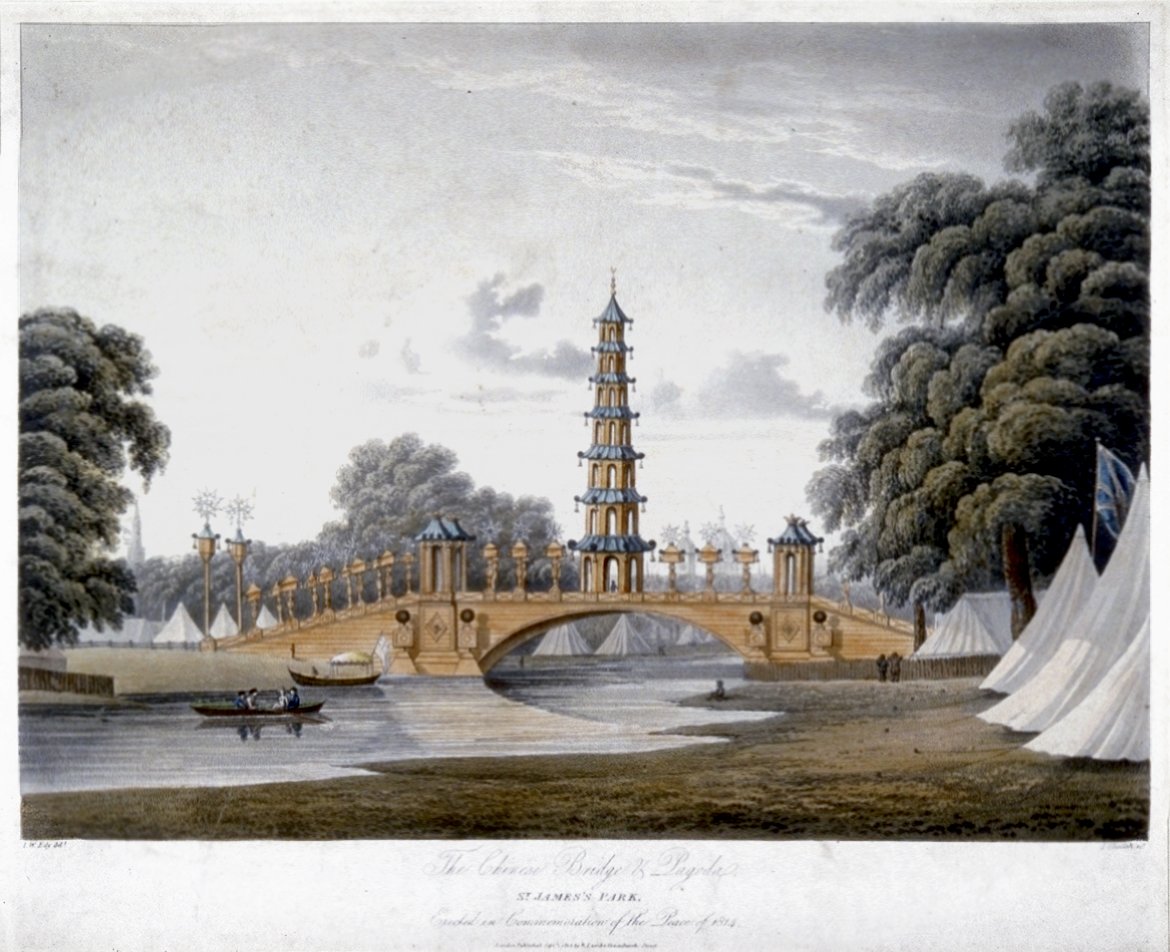The Chinese Bridge and Pagoda, St. James’s Park, Erected in Commemoration of the Peace of 1814
John William Edy (1760 - c.1830)
Joseph Gleadah
Colour aquatint
published 1 September 1814
-
About the work
- Location
-
Country: France
City: Paris
Place: British Embassy
This aquatint depicts the Chinese bridge and pagoda, a temporary structure erected in St. James’s Park in 1814. It was commissioned by the Prince Regent from architect John Nash, to form part of the ‘Grand Jubilee’ celebrations. The Jubilee marked the anniversary of the Battle of the Nile (1-3 August 1798) and the centenary of the accession of the House of Hanover. A gala, organised by the Prince, was held in St. James’s Park on 1 August 1814.
The centrepiece of the gala was the seven storey, 80 feet high, Chinese pagoda, rising from the centre of a bridge, spanning the Canal (in fact a lake) in the park. The bridge and pagoda were made in wood, painted yellow with blue roofs. The pagoda was lit at each level by gas-flame lighting and oil-lamps. Pillars along either side of the bridge supported boxes of fireworks, to be ignited as a grand finale to the celebrations. However, during the firework display the pagoda caught fire. An enthralled crowd of spectators assumed the burning structure was part of the spectacle, until cries of distress were heard from the tower. Most of the pagoda eventually toppled into the Canal and two carpenters were killed in the disaster. The bridge survived until 1825.
-
About the artist
Painter and engraver John William Edy was probably born in Denmark, but arrived in England at a young age. In 1779 he entered the Royal Academy Schools as a painter. He later worked as an engraver on R. H. Colebrook's ‘Twelve Views of Places in the Kingdom of Mysor’ (1794), produced plates after marine views by Robert Cleverley and after sporting designs by John Nost Sartorius. In 1800, Edy travelled to the coast of Norway to make drawings for publisher John Boydell’s ‘Picturesque Scenery of Norway’ (1820). He exhibited at the Royal Academy in 1785, 1801 and 1802 and at the British Institution in 1807. In 1812 he was imprisoned for his debts at the King’s Bench Prison, Surrey. His estate and effects were distributed in the following year.
-
Explore
- Places
- England, London, St. James's Park
- Subjects
- rowing boat, topography, townscape/cityscape, tree, lake, flag, park, footbridge, pagoda, tent/marquee
- Materials & Techniques
- aquatint, colour aquatint
-
Details
- Title
- The Chinese Bridge and Pagoda, St. James’s Park, Erected in Commemoration of the Peace of 1814
- Date
- published 1 September 1814
- Medium
- Colour aquatint
- Acquisition
- Purchased from Parker Gallery, September 1961
- GAC number
- 5604